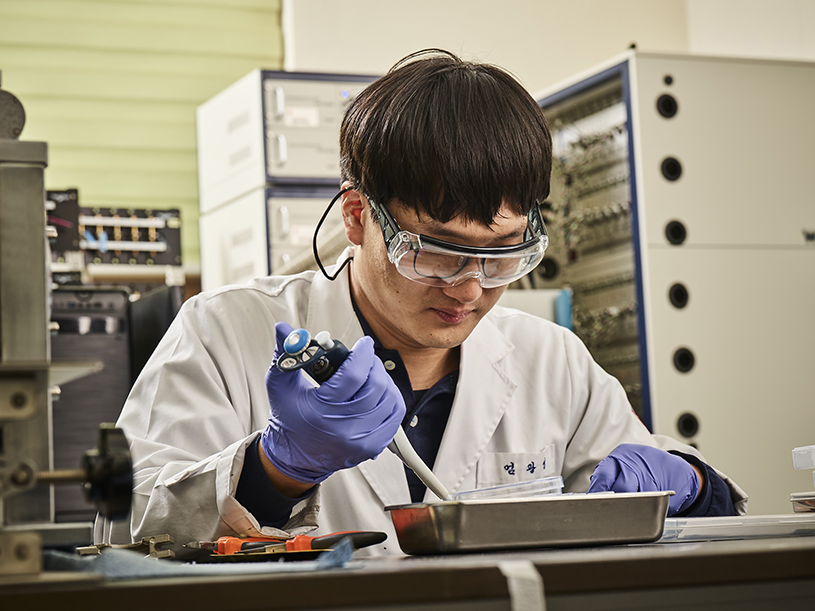Smaller, lighter, safer
Professor Kwang-sup Eom, researchers Seung Min Lee and Ha Eun Lee, School of Materials Science and Engineering
New material engineering studies the development of high-tech materials used in various hightech
science technologies, such as information engineering, bio-engineering, nano-technology,
environment technology, and space technology. The School of Materials Science and Engineering
at GIST trains research experts to be pioneers in the high-tech industry and has succeeded in
developing highly stable, high capacity batteries. We met with Professor Kwang-sup Eom, Seung
Min Lee, and Ha Eun Lee, a research team at the School of Materials Science and Engineering.
Are there areas where the small battery that you are currently researching on can be applied to
daily life?
Prof. Eom
Small batteries don't just refer to small batteries literally but also includes developing
batteries with high energy storage capacity per volume and miniaturizing them. We have
developed materials capable of storing a lot of energy and operating stably, compared to materials
that were previously used that centered on battery electrode material. In other words, selenium
electrode material in pervious batteries had the problem of rapid drop in initial performance, and
we were looking for measures to clearly investigate the root cause in order to reduce drop in
performance.
Seung Min Lee In a broad spectrum, there is a large capacity storage device called energy storage
system (ESS). I think it would be good to utilize as the volume can be minimized when compared
to existing materials, and I think it would be convenient to use it in mobile applications that
require small volume.
Prof. Eom In particular, the biggest advantage is that the material price is affordable. It would
probably be useful particularly in mobile areas. If it is made in the same size, the energy capacity
would increase by two-fold, so it can be used for a long period of time. To achieve the same
capacity, the volume decreases so the entire weight of the mobile product would become lighter.
홍You conducted joint research with Hongik University and Kyung Hee University research teams.
Please tell us about the background and also some episodes, if any.
Prof. Eom They have conducted joint research when I was studying in the US. Their majors are
mostly high polymers, and I am involved in developed energy material based on electrical science.
This research was about surface treatment using high polymers. So, we were able to achieve
good results in battery performance, and I requested for their assistance in order to gain advice
regarding surface analysis to investigate the phenomenon, particularly concerning high polymer
analysis, and they willingly offered their assistance.
Ha Eun Lee Professor Jae Han Jung from Hongik University came a long distance without
hesitation and made analysis until late at night, so I was grateful.
What’s are your future research plans?
Your paper was also published in an international science academic journal. Please tell us how you
feel about it.



